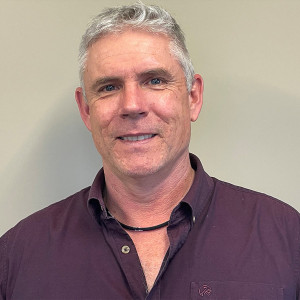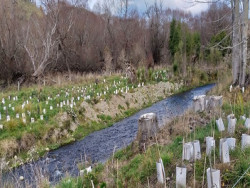Ōrāri Temuka Ōpihi Pareora Water Zone Committee progress report
Each of Waitaha/Canterbury’s water zone committees has an action plan which outlines how they will work with the community to deliver their aspirations for freshwater as outlined in the Canterbury Water Management Strategy (CWMS). Committees report annually to let the community know how things are tracking.
2022/23 Progress report
From the chair

Glen Smith, OTOP Water Zone Committee chair
I would describe the past year as being one of "housekeeping" as the committee completed a transition from its focus on informing regulatory processes (via the Zone Implementation Programme Addenda for PC7) to its current focus on supporting and encouraging hands-on non-regulatory environmental work within the zone.
Much of this housekeeping has been bringing clearer structure, process, and transparency to the administration of funding recommendations. It is hoped this will reduce perceived barriers and encourage more groups/projects to apply for funding for environmental enhancement projects.
Following local government elections, the zone committee welcomed new representatives appointed by their respective Councils:
- Cr Michelle Pye – Timaru District Council
- Cr Sharyn Cain – Waimate District Council
- Cr Phillipa Guerin – Mackenzie District Council
- Cr Deon Swiggs – Environment Canterbury
The committee also welcomed Rynee de Garnham as the Te Rūnanga o Waihao representative and farewelled community member Brian Basset-Smith.
Whilst the changing faces around the committee table can bring a period of getting up to speed, this year it has also brought fresh perspectives and energy to move forward after being part of the drawn-out process of informing the now partly-operative Plan Change 7.
Glen Smith.
Key achievements for 2022/23
- Supporting Catchment Collective South Canterbury to host and organise education for catchment groups to build skills relevant to their environmental care activity
- Supporting farmer shareholders in the Opuha Irrigation Scheme to implement actions in their biodiversity plans
- Supporting restoration of native planting along the Ōpihi River at Te Kopi-O-Te Ōpihi/Burkes Pass
- Supporting restoration of native planting at Te Ahi Tarakihi stream in Timaru
- Contributing to the development of the Waitarakao Washdyke Lagoon Catchment strategy, including having a member on the Our Waitarakao project working group.
Local projects helping to deliver on CWMS targets
Read some of the stories about what is being done in the zone to deliver on the CWMS targets.
Working with key partners

Ōpihi River
The zone committee provided funding to Opuha Water Limited (OWL) towards its programme to protect, restore, enhance, and create biodiversity on shareholders' properties.
Support from the zone committee will allow OWL to extend biodiversity projects across more applicants. The completed biodiversity plans cover an area of approximately 35,050 hectares and identify 634 areas on farms for action. There are a number of properties that are situated within known bat roosting areas or that have known Significant Natural Areas (SNAs).
Additionally, many properties are located within the Rock Art Management Areas and the Mātaitai and Waipuna Protection Zone, as identified and mapped through Plan Change 7.
This work helps meet these CWMS targets: Ecosystem health and biodiversity
Action Plan budget project
Water zone committee members out on a field trip
The zone committee funded the Catchment Collective South Canterbury Society (now renamed Living Landscapes SC) to host and organise education for members of South Canterbury catchment groups to build skills relevant to their environmental care activity.
The funding covers:
- Training and advice on Farm Environment Plans (FEP) via FEP workshops, particularly with a catchment-wide context. Living Landscapes SC is collaborating with Beef+Lamb NZ enabling farmers and their catchment communities to understand catchment-specific risks, appropriate mitigations, and catchment priorities.
- Training catchment group leaders on how to better engage with local rūnanga (either through Te Tiriti o Waitangi training or similar). The catchment groups recognise that partnering with rūnanga will be invaluable in promoting the health and wellbeing of water, and hope that this learning will aid such partnerships.
- Provision of compact and easy-to-use environmental (eDNA) kits to enhance the understanding of life in waterways and enable better on-farm and catchment management decisions.
This work helps meet these CWMS targets: Ecosystem health and biodiversity and Kaitiakitanga
Groundwork in the zone

Planting by the Ōpihi River
A major restoration project at Te Kopi-O-Te Ōpihi/Burkes Pass will eventually transform a stretch of the upper Ōpihi River adjacent to the Burkes Pass township, restoring an ecosystem and enhancing the natural character of the area. A new public walking track is also planned and will extend the existing Burkes Pass Heritage Walk by an extra kilometre.
The site has significant cultural value for mana whenua as it was once used as a major travel route and was an important place for gathering kai and resources. The zone committee supported this project last year with funding from its Action Plan budget and this year further was provided.
The project will be completed in stages and is a joint effort between Te Kete Tipuranga o Huirapa Ltd (Arowhenua Native Nursery), the Burkes Pass Heritage Trust, and Headley Greene Farm.
The CWMS targets are: Ecosystem health and biodiversity, Natural character of braided rivers, Kaitiakitanga and Recreational and amenity opportunities
Delivering the community's vision for freshwater
The Canterbury Water Management Strategy (CWMS) puts some responsibility for finding solutions for freshwater management in the hands of the community, with support from councils, Ngāi Tahu, and others. The strategy sets out freshwater goals and targets to deliver the community’s vision for freshwater.
Each of the community-led water zone committees work collaboratively to develop freshwater recommendations for councils to help ensure plans give effect to these goals and targets.
Within each target area, there are several specific time-bound targets to be achieved and these are monitored and reported on to ensure progress is being made.
The CWMS targets are: Environmental limits, Ecosystem health and biodiversity, Natural character of braided rivers, Kaitiakitanga, Drinking water, Recreational and amenity opportunities, Water use efficiency, Irrigated land area, Energy security and efficiency and Indicators of regional and national economies.
Future challenges and opportunities – 2023/24
In the regulatory space, the OTOP community is facing many changes including the new Regional Policy Statement being developed, the long-awaited implementation of Plan Change 7, and the interpretation and implementation of Te Mana O Te Wai.
In terms of environmental protection and improvement, there are many challenges including:
- Our coastal lagoons are under threat from both seaward and landward pressures
- Water quality for contact recreation has declined at Evans Crossing
- Habitat protection and predator control for the critically endangered pekapeka/long tail bat population
- Changing weather patterns
- Protection of rock art through spreading awareness about the importance of rock art sites and the need to protect them, and supporting landowners to do so
- The conclusion of central government funding, which has recently been supporting projects such as Ōpihi Lagoon and the Rakitata Revival project. The zone committee sees a need to move from a short-term focus to a long-term one. With existing funding mechanisms, it will be difficult to sustain the progress already made. At a minimum, we must protect what has been achieved but ideally, we should build on the good mahi done.
The zone committee will continue to collaborate with groups such as Living Landscapes, catchment and community groups, councils, and mana whenua to support their work and assist with funding where possible.
